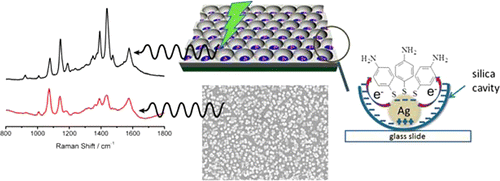Exploring the Chemical Enhancement of Surface-Enhanced Raman Scattering with a Designed Silver/Silica Cavity Substrate
Shu Tian †‡, Qun Zhou *†(周群), Chuanhong Li †, Zhuomin Gu †, John R. Lombardi §, and Junwei Zheng *† (郑军伟)
† College of Chemistry, Chemical Engineering and Materials Science, Soochow University, Suzhou 215123, P. R. China
‡ School of Chemistry and Chemical Engineering, Nantong University, Nantong 226007, P. R. China
§ Department of Chemistry, The City College of New York, New York, New York 10031, United States
J. Phys. Chem. C 2013, 117, 556–563.
Silver nanoparticles were assembled onto the bottom of closed-packed silica cavity using polystyrene (PS) spheres as template. Charge transfer between the adsorbed 4-aminothiophenol (PATP) and the silver nanoparticles was studied using surface-enhanced Raman spectroscopy with 514, 633, 785, and 1064 nm excitation, and compared to that of the immobilized silver nanoparticles without the modification of silica cavity. Using the concept of degree of charge transfer, we directly observed the additional chemical enhancement without a deliberate distinction between electromagnetic (EM) enhancement and chemical enhancement. It was demonstrated that the negative charges of the silica could induce the formation of the dipole in the nanoparticles, thus enlarging the electron density at the sites where probe molecules adsorbed, and leading to higher charge transfer from the metal to the adsorbed PATP molecules. We also proposed another model to further elucidate the relationship between the electron density and the charge transfer. The result showed that the reduction of the electron density of silver nanoparticles will cause the redistribution of the dipole, thereby reducing the charge transfer degree.
